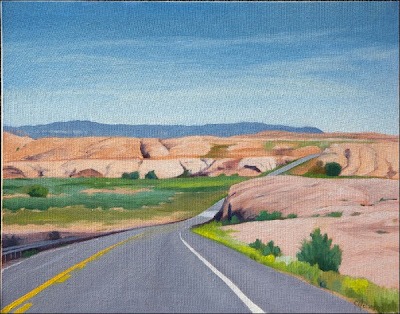No painting today; instead, we took advantage of the mild weather (read: a sunny day with no wind and temps in the high 30's) to head up Hwy 550 to Molas Pass to snowshoe.
Winter, for me, is a contemplative time of the year. Everything is subdued and at rest, and there is a sense of peace and tranquility that aren't present during the rest of the year. As one who doesn't handle cold or short days particularly well, and loves being outdoors, winter is admittedly my least favorite season. I found it particularly difficult when living in Connecticut, as the skies were often gray and the damp, bone-chilling cold and wind made it unpleasant to be outdoors at any time. I found the landscape to be dreary and utterly depressing.
However, after our move to Durango, I found I wasn't dreading winter as I had while living in New England. In addition to returning to a landscape that remains attractive in winter, I was excited to be able to resume winter recreational activities I'd enjoyed while living in northern AZ, namely snowshoeing. I love the ability to head out into the backcountry and enjoy the solitude and quiet that come with snowshoeing, along with the ability to go virtually anywhere.
As predicted, Molas Pass (~10,900') had plenty of snow from the recent storms that went through the area, and ideal conditions for snowshoeing and Nordic skiing. We went along the road to Little Molas Lake and the Colorado Trail (CT). The day and the scenery were just spectacular, and we were blessed that the area wasn't over-run with noisy, obtrusive snowmobilers.
Here are a few photos from the day that I hope you'll enjoy:
Sultan and Grand Turk Peaks
This is the view to the north just off of the road leading to the CT trailhead. For a fun comparison,
here are photos from the same trail taken during the late summer hike we did.
Twilight Peak
A view to the south along the road shows Twilight (tallest) with Snowdon Peak to the left.
Winter still life
Dried grasses emerge from the snow to cast delicate shadows in the low afternoon light.
Little Molas Lake and Twilight
Another view of Twilight Peak, with LML in the left foreground, frozen, of course. A couple was actually ice fishing on the edge of the lake.
Me with LML and the Grenadier range in the distance.
A rare photo, since I'm usually behind the lens. I look like some sort of snow hippy with the vest and ear band, and it was warm enough that I didn't really need them.
Snow along the road here was less than 1', but in other areas was over 2', making for slow going and a real workout.
Crystalline abstract
While heading up a hill for a view of Engineer, I noticed these amazing and delicate ice crystals forming along the edges of the snow and in the shallow depressions. I never miss a chance to find abstractions in nature, and this was a novelty for me.
Engineer Peak
Looking great, as always, in this view to the west.
We are south of the CT here, which is also about 50-100' higher on the side of the ridge.
Criss-crossing
Tracks from an earlier snowmobile romp form a interesting shadow pattern against those of the evergreens.
I love colors formed by cast shadows on snow, and always spend a lot of time observing the subtleties in colors and values that are present. In this case, my camera did a respectable job of capturing the range of blues.
Long shadows and tall clouds
More glorious shadows cast by the omnipresent evergreens back near the start of the road. A lenticular type cloud adds some contrast via its curves and amorphous shape.





















































